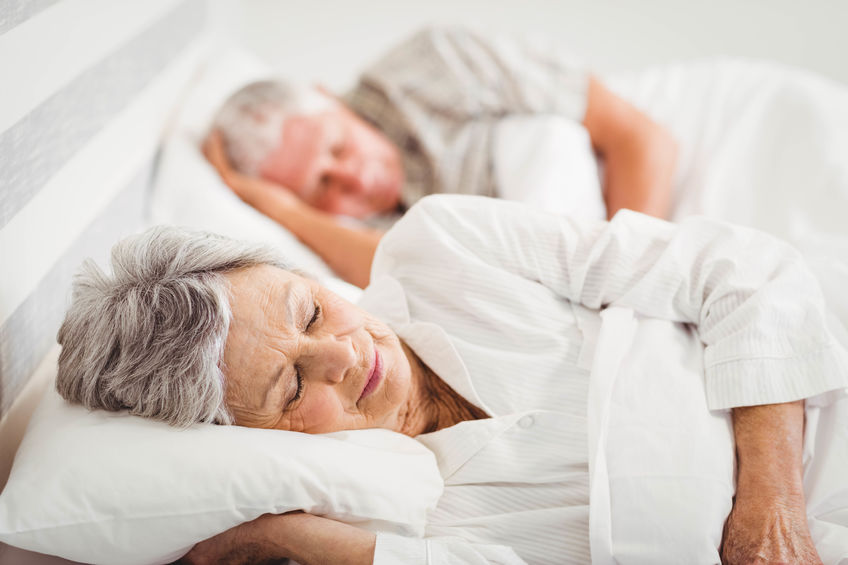So many older adults have trouble sleeping due to pain or just not being able to get comfortable. These are some good tips to ensure better sleep.

11 Tips to Improve Senior Sleep by Reducing Pain and Discomfort
© By DailyCaring Editorial Team
“1. For side sleepers
At 7 minutes 32 seconds in this video, physical therapists demonstrate how to achieve a well-supported sleep position for a side sleeper.
Key points:
Use enough pillows under the head to keep it in a neutral (middle) position, which keeps the spine aligned from neck to body
To reduce pressure on the lower shoulder, add a pillow under the torso, leaving space for the arm (8 min 34 sec in video)
Add a pillow between the knees or lower legs to keep the hips, pelvis, and spine aligned
To reduce pressure on the upper shoulder, add a pillow under that arm (9 min 20 sec in video)
2. For back sleepers
At 6 min 43 sec in this video, physical therapists demonstrate how to achieve a well-supported sleep position for a back sleeper.
Key points:
Don’t use too many pillows under the head so the neck isn’t forced to bend forward
Add a pillow or a leg wedge under the knees to keep the lower back in a neutral position
3. For stomach sleepers or degenerative disk disease
Generally, sleeping on the stomach isn’t recommended because it’s hard on the back, but long-held habits can be tough to break.
However, stomach sleeping may be helpful for people with degenerative disk disease (see #3 in this list).
Key points:
Use a very thin pillow under the head or no pillow at all
Place a thin or medium pillow under the stomach or pelvis
Bring one leg to side and slightly bend it, put a pillow under this knee
4. For general back pain
To relieve back pain, it’s best to sleep on the side or back, following the tips in #1 and #2 above.
5. For those who prefer a reclining chair or for isthmic spondylolisthesis
Some older adults might just prefer to sleep in a reclining chair.
Sleeping in a reclined position is also helpful for a condition called isthmic spondylolisthesis. That’s where one of the lower vertebra slips forward onto the bone directly beneath it. Sleeping in a reclined position (#5 in this list) takes pressure off the spine.
A bed wedge is an inexpensive option that mimics a recliner chair’s shape. A more expensive option is to consider an adjustable bed.
6. For herniated disk
A helpful sleeping position for back pain caused by a herniated disk is the fetal position, #2 in this list. Sleeping curled up opens the space between the vertebrae.
7. For general neck pain
The best sleeping positions for neck pain are the back or side because they keep the neck and spine aligned with the body. Use the correct pillow height, following the tips for side and back sleepers in #1 & 2 above.
It’s best to avoid stomach sleeping because the head is twisted to the side, which puts pressure on nerves in the neck.
8. For general hip pain
For hip pain, sleep on the “good” side with knees bent. Use the side sleeping tips in #1 above to keep the hips, pelvis, and spine aligned.
9. For general knee pain
To ease knee pain, sleep on the side or back using the tips in #1 and 2 above and keep the knee in a comfortable, slightly bent position.
10. For general shoulder pain
To relieve shoulder pain, have your older adult sleep on their back with a small pillow under the painful shoulder. Or, sleep on the side on the “good” shoulder and follow the tips in #1 above.
11. For heartburn or GERD
To relieve the discomfort of heartburn or GERD while sleeping, it helps to sleep on the left side and elevate the head of the bed to create an incline. Or, use a bed wedge to put the head and torso on an incline.
Avoid using extra pillows under the head because that doesn’t put the stomach area on an incline, which is what helps the stomach acid stay down in the stomach.”
Click here to read the full article.
Moon River Senior Care and Transportation is a licensed Home Health Agency committed to helping older adults maintain independence and quality of life.




